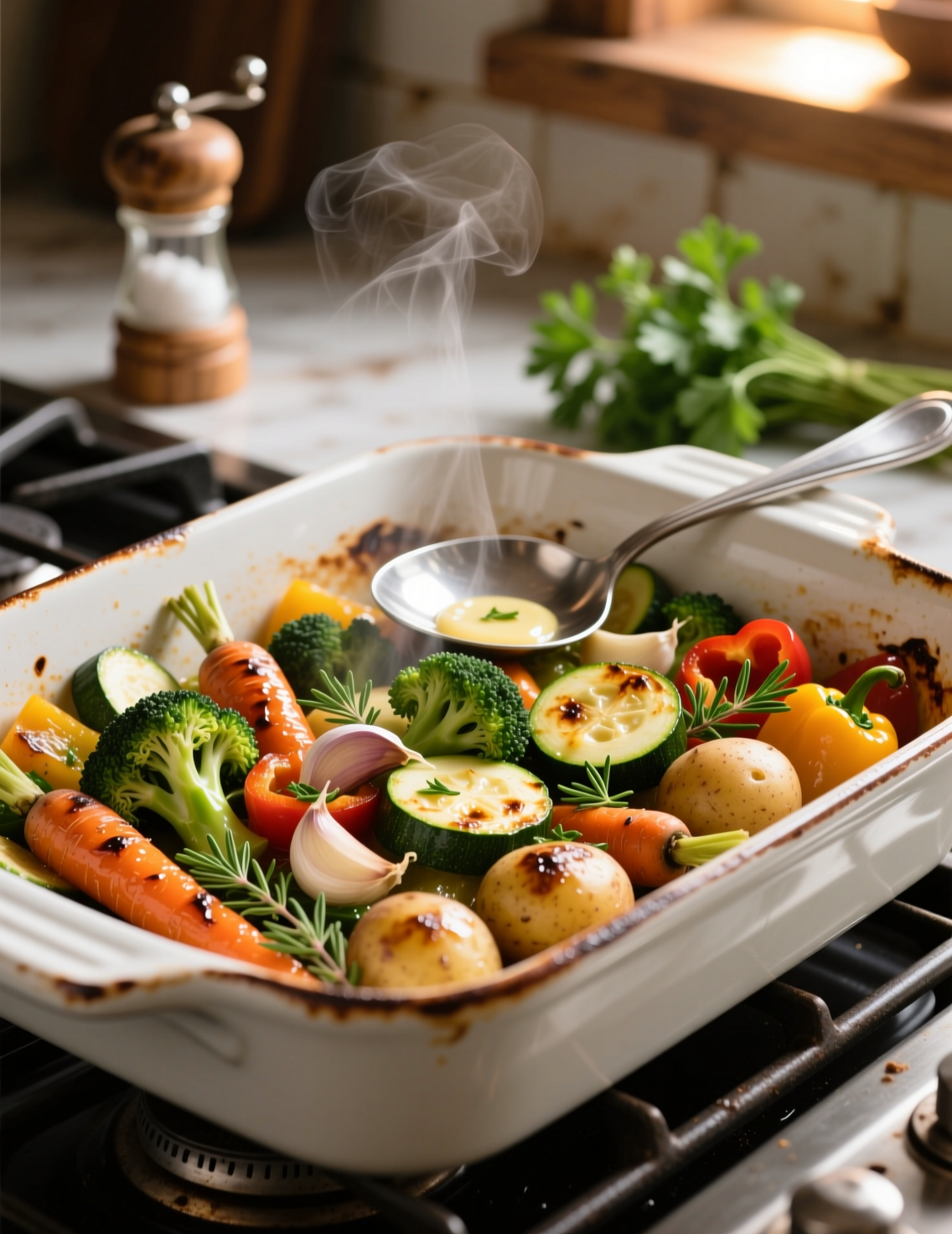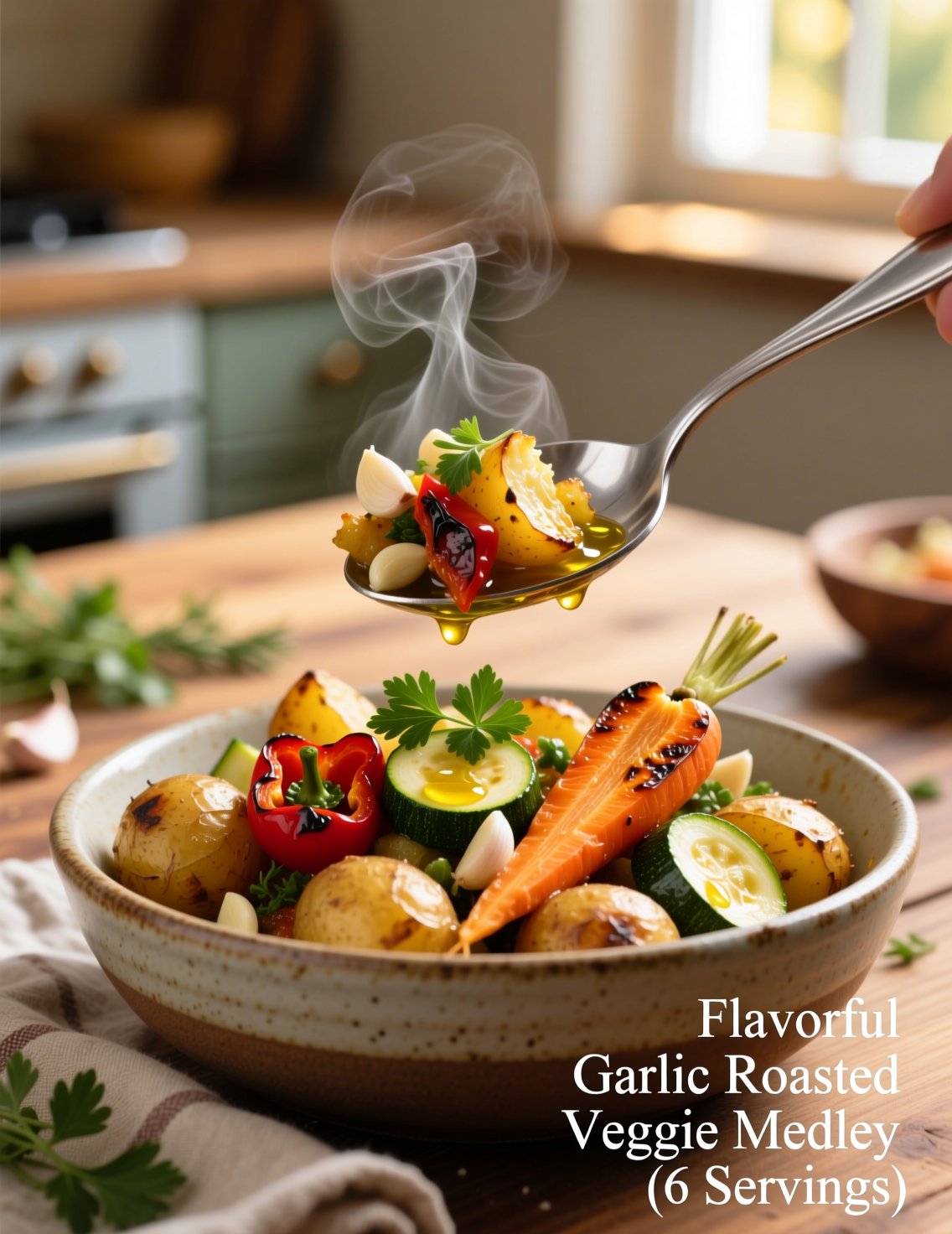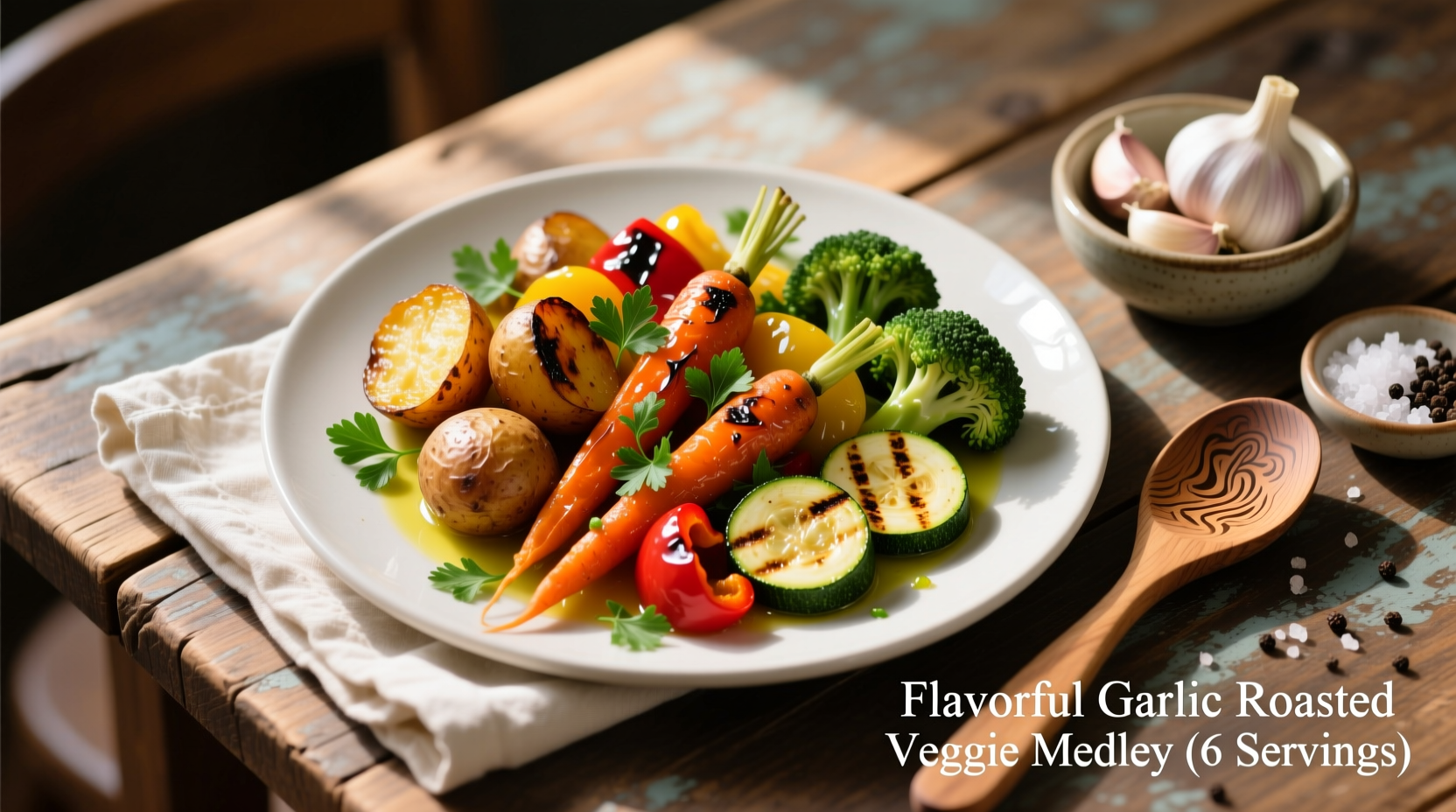The hum of an oven filled with roasting vegetables is one of those small, grounding sounds of life. The aroma of caramelized garlic hitting the air, the faint hiss as olive oil bubbles around crisping edges—it’s a sensory masterpiece. A good roasted veggie medley isn’t just a side dish; it’s an art form. Today, we’re diving deep into the craft of making a Flavorful Garlic Roasted Veggie Medley that serves six hungry hearts and satisfies even the most discerning palate.
Why Garlic Roasted Vegetables Matter
There’s roasting veggies, and then there’s doing it right. The key difference lies in balance—temperature, oil distribution, and the garlic-to-veg ratio. Too much oil, and you’ll drown the texture. Too little, and you’ll end up with limp, unevenly cooked vegetables that taste more steamed than roasted. Garlic bridges the flavor gap—it transforms under heat, moving from sharp and pungent to mellow and nutty.
A 2019 study in Food Chemistry found that roasting at moderate-high heat (around 400°F or 200°C) significantly enhances the antioxidant profile of vegetables like bell peppers, broccoli, and carrots. It’s not just flavor; it’s functional nutrition.
The Perfect Medley: What Goes In
Here’s where most people get it wrong. They toss random vegetables together like a lucky dip at a farmer’s market. But each vegetable carries its own moisture content, density, and sugar level. Mixing without logic means some will burn while others barely cook through.
For a balanced roast that serves six, you’ll need:
- 2 medium carrots, sliced on a diagonal
- 1 large zucchini, halved and cut into half-moons
- 1 yellow bell pepper, chopped into large chunks
- 1 red bell pepper, same size
- 1 small red onion, cut into wedges
- 1 head of broccoli, florets only
- 3 tablespoons extra virgin olive oil
- 6 cloves garlic, smashed and roughly chopped
- 1 teaspoon kosher salt
- ½ teaspoon freshly ground black pepper
- 1 teaspoon smoked paprika (optional, but oh, it’s good)
- Fresh thyme or rosemary sprigs
Every element here has a purpose. Carrots bring sweetness. Zucchini adds soft, buttery notes. Bell peppers lend vibrancy and a slight char flavor. Broccoli adds crunch and color. The onion ties everything together with its caramel tone.

The Art of Preparation
A chef once told me, “You don’t cook vegetables, you coach them.” Meaning—you create the right conditions, and they reveal their best selves. Preparation starts long before the tray hits the oven.
Wash the vegetables thoroughly, but never soak them. Water clinging to the surface will steam, not roast. Pat dry with a clean kitchen towel. Cut each vegetable roughly the same size, about ¾-inch thick. This ensures even cooking.
Smash the garlic cloves rather than mincing them to prevent burning. The smashed bits roast gently, releasing flavor without bitterness. Toss everything in a large bowl with olive oil, salt, pepper, and paprika until lightly coated—just enough to glisten. If the veggies start to pool oil at the bottom of the bowl, you’ve gone too far.
Oven Temperature: Where the Magic Happens
The ideal roasting temperature sits between 400°F and 425°F (200–220°C). That’s hot enough to caramelize the sugars but not so hot that your vegetables dry out. Spread them across a large baking sheet in a single layer. Overcrowding is the cardinal sin—space is flavor.
Roast for 25–30 minutes, stirring halfway through. This isn’t just to prevent burning—it redistributes moisture and encourages even browning. You’ll know they’re done when the edges turn crisp golden, and the garlic pieces are deep amber, not black.
The Chemistry Behind That Flavor
When garlic and vegetables hit high heat, something called the Maillard reaction takes over. This is where amino acids and sugars interact to create complex, savory notes—the “roasted” taste we crave. According to research published in the Journal of Agricultural and Food Chemistry, this reaction boosts umami perception and volatile compounds responsible for aroma intensity.
That’s why roasted garlic smells so intoxicating—it’s not just cooked; it’s transformed. It’s also why using real olive oil (not vegetable blends) is crucial. Olive oil’s phenolic compounds enhance the Maillard effect while offering antioxidant benefits.
Pro Tips from the Professional Kitchen
Here’s where expertise steps in. Anyone can roast vegetables, but making them exceptional requires a few pro secrets:
1. Preheat the baking sheet.
Slide your empty pan into the oven during preheat. When you spread the veggies on a hot surface, they sizzle instantly, developing a perfect sear without sogginess.
2. Use two pans for six servings.
It’s tempting to cram everything on one, but resist. Spread across two sheets if necessary. The more airflow, the better the roast.
3. Finish with acid.
A drizzle of balsamic reduction or a squeeze of lemon just before serving brightens the flavor profile. Acid lifts the richness and wakes up the palate.
4. Don’t peel everything.
Keep the skins on carrots and zucchini if they’re young and tender. That’s where much of the fiber and nutrients live.
5. Play with herbs.
Rosemary and thyme are classics, but try sage or oregano for a Mediterranean twist. Add them near the end, not at the start, so they don’t burn.
Nutritional Value: What You’re Really Eating
A serving of this garlic roasted veggie medley packs roughly:
- Calories: 180
- Protein: 4g
- Fiber: 6g
- Vitamin C: Over 100% of daily value
- Vitamin A: Around 70% DV
- Healthy fats: 8–10g
Roasting not only enhances flavor but preserves key nutrients better than boiling or frying. For instance, bell peppers retain up to 80% of their vitamin C content after roasting, compared to just 45% when boiled.

Flavor Variations for Professionals
If you’re cooking for different cuisines, here are a few professional-grade adaptations:
Mediterranean Style: Add cherry tomatoes, olives, and a dusting of feta after roasting. Drizzle with lemon juice and olive oil.
Asian Twist: Replace olive oil with sesame oil, add a splash of soy sauce and a sprinkle of toasted sesame seeds.
Middle Eastern Touch: Add cumin, coriander, and a dollop of tahini drizzle. Finish with chopped parsley and pomegranate seeds.
Italian Roast: Incorporate small cubes of eggplant and toss with basil pesto post-roast.
Each variation demands awareness of flavor layering. Professionals understand that the base (the vegetables and garlic) is a canvas, not a cage.
Common Mistakes Even Pros Make
Yes, even experienced cooks mess up sometimes. The biggest issue? Moisture management. Vegetables with high water content—like zucchini and mushrooms—release steam. If you overcrowd, that steam gets trapped, and everything softens instead of crisps.
Another common oversight is timing. Garlic can burn faster than most vegetables. Keep an eye during the last five minutes. A burnt clove can throw off the entire batch with its acrid taste.
Also, never use aluminum foil directly under the veggies—it reflects heat unevenly. Parchment paper is your best friend.
Pairing and Serving Ideas
Roasted vegetables pair beautifully with almost anything. Serve them alongside grilled salmon, roasted chicken, or even toss into quinoa for a hearty vegetarian main.
They also reheat beautifully. Store leftovers in an airtight container for up to four days. Reheat in the oven, not the microwave, to preserve texture.
One of my favorite tricks is using leftovers in omelets or wraps the next morning. The roasted garlic infuses the eggs like a hidden seasoning.
The Science of Garlic Intensity
Here’s a fascinating bit of chemistry: raw garlic contains alliin and alliinase, compounds that combine when chopped to create allicin—the source of garlic’s pungency. But allicin is heat-sensitive. During roasting, it breaks down into diallyl sulfides, which are milder and sweeter.
In simpler words, roasting turns garlic from fiery to friendly. That’s why adding raw garlic after roasting (as some do for extra punch) reintroduces sharpness. It’s all about balance and timing.
The Professional’s Mindset
Cooking isn’t about rigid recipes; it’s about intuition. A professional chef doesn’t just follow measurements—they read the vegetables. Is that carrot too thick? Slice it thinner. Is the broccoli dense? Give it more time.
It’s this adaptability that turns a simple recipe like garlic roasted veggies into a chef’s signature dish. Consistency comes from observation, not automation.
Expert Insights from Culinary Research
A 2021 analysis in Frontiers in Nutrition confirmed that roasting enhances flavor complexity more effectively than any other cooking method. The study noted higher production of aroma-active aldehydes and ketones, especially in garlic-based dishes.
That’s scientific backing for what chefs already know intuitively: roasted veggies taste more alive.
Another interesting note—adding herbs at the end preserves their volatile oils, responsible for aroma intensity. So when chefs throw herbs post-roast, it’s not aesthetic—it’s chemistry.
The Final Touch: Presentation
You could toss your veggies in a bowl and call it a day, but professionals know that presentation amplifies perception. Serve them on a warm platter, drizzle with a touch of olive oil, and sprinkle flaky sea salt right before serving.
Contrast matters. The deep greens and oranges against a white ceramic plate—eye candy before the first bite.
In Closing
The Flavorful Garlic Roasted Veggie Medley isn’t just a recipe—it’s a masterclass in technique, balance, and sensory awareness. It’s proof that simplicity, handled with precision, beats complexity every time.
For professionals, the lesson is clear: perfection isn’t found in ingredients alone, but in how they’re treated. Listen to the sizzle, trust your instincts, and let the garlic lead the way.
Because when you pull that tray from the oven, golden and fragrant, you’ll know—you didn’t just make dinner. You made harmony.
FAQs
How long should I roast the vegetables for?
About 25–30 minutes at 400°F, stirring halfway for even browning.
Can I use frozen vegetables for this recipe?
Yes, but thaw and pat them dry first to prevent sogginess.
What’s the best oil for roasting vegetables?
Extra virgin olive oil gives the best flavor and helps with caramelization.
How do I keep the garlic from burning?
Smash, don’t mince, and toss it in midway through roasting if needed.
Can I roast different veggies together?
Yes, just cut them to similar sizes so they cook evenly.
How do I make the veggies extra crispy?
Use a preheated baking sheet and avoid overcrowding.
What herbs pair best with roasted vegetables?
Thyme, rosemary, and sage add great aroma and earthy flavor.
Can I add protein to make it a full meal?
Absolutely—toss in chickpeas or serve with grilled chicken or fish.
How should I store leftovers?
In an airtight container in the fridge for up to four days.
How can I reheat roasted vegetables properly?
Reheat in a hot oven for 8–10 minutes to keep them crisp, not in the microwave.

Mariana is a passionate home cook who creates delicious, easy-to-follow recipes for busy people. From energizing breakfasts to satisfying dinners and indulgent desserts, her dishes are designed to fuel both your body and hustle.
When she’s not in the kitchen, she’s exploring new flavors and dreaming up her next recipe to share with the Foodie Hustle community.

